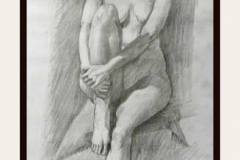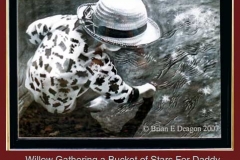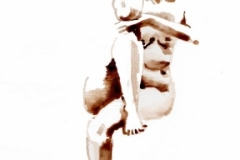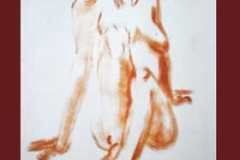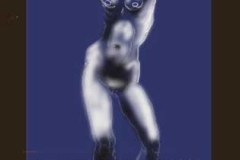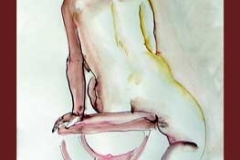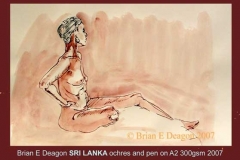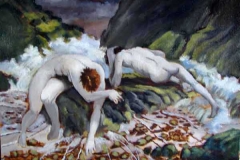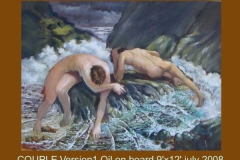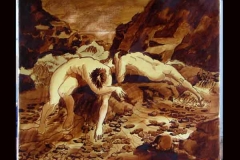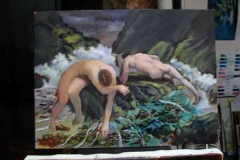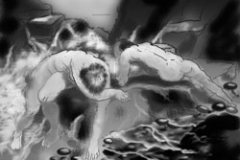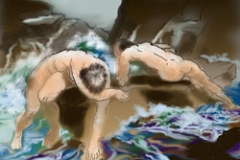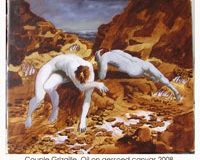AN ATELIER DRAWING LESSON
Ryan Daffurn’s teaching is not what I expected. And that’s a good thing. We began a long drawing (say 10 hrs) with the admonition to get something down about the design or rhythm of the long lines of the pose in about 2 minutes.
This really surprised. I expected plumb lines to the weight bearing foot, “envelopes” within which details could be developed, and “measure, measure and measure again, after determining the eye level and viewpoint.” Apparently he wants me to work by a succession of approximations, refining and correcting as I go. Gradually I began to understand that accurate construction of design and anatomy can only begin with the whole. The same applied to light, which is constructed by mathematical logic as much as ” accidents of nature.” For example the skin tone differences between sun exposed neck and pale sun deprived chest might be noted or ignored, depending upon the conception. One things for certain, it’s not “look and put” realism. He begins with the overall conception, and is quite happy to idealise( or,if you will,”distort”) for the sake of clarity, gracefulness, dynamism or emotion in the pose.
We really need to say more about what I see as Daffurn’s idealism. It’s not the kind where everyone has a “Greek” nose and all female breasts defy gravity in their perfect cones. It goes much deeper philosophically in a Kantian or Heideggerian sense. It comes from a reverence for the constructed body, and a profound understanding of its structure in three dimensions, and the fourth dimension being potential movement in time, and all within a space of light and colour, revealing and concealing the body at the same moment.
Nothing really needs to be invented, just deeply understood. It’s a proud stance, underpinned by humility. Incidentally, the controlled art studio lighting is not mandatory, it’s just a help to the student. This is all based on a reverence for nature and the body we inhabit. More than that, it presupposes a profound belief in the intelligence of artist and audience, and the visual language they use. We intend to edify our viewer, not shock them This might not be fashionable, but it’s not “dead” as some post-structuralists might claim. To invoke beauty,hope,intelligence,diligence,persistence,structure, design etc may be idealistic and even naïve, but its not wrong..
Drawing of this kind is much more than a skill set or an arcane knowledge. It implies a moral relationship between artist and model I keep using the word “profound”. Because it is
Post script.17/5/13 Studying still life with Ryan is a revelation. I should have expected him to have the same attitude to colour and light as to form. And he does. Once again he is insistent upon the overall conception of light and colour interaction with our perceptual biology. I keep “seeing” what he expects me to ignore. I cannot paint without responding to the incident, the “flash”, the particulars.
Fighting the habits of a lifetime is starting to yield some suprises though, but the actual mechanics of eye movement and focus and the time element when shifting focus I am really struggling with. Its easy to say, “we see with the mind, not the eye ‘. All problems are solvable provided approached systematically. For example, it takes longer to mix my colours than it does to paint the picture, another dimension of the academic method no doubt!
Post script 26/8/13The advice to see and construct the perfect, or idealized sphere as a first step is critical. Only then is it possible to show the shadow shapes, the terminator between light and dark, the form shadow, the cast shadow and all the detail of representation. It is an intellectual activity to construct this ideal world, and an artist should be able to do this without “reality” in front of them. THEN the perceptual takes over, noting the “accidents of nature” nuances of colour, texture and shape.Even here, an algorythm can be developed, like in fractals, to complete the texture of the orange without copying a particular. As I work with Ryan, I am beginning to see how idealism (mind) and realism (perception) work together. Brian E Deagon 29/12/12
